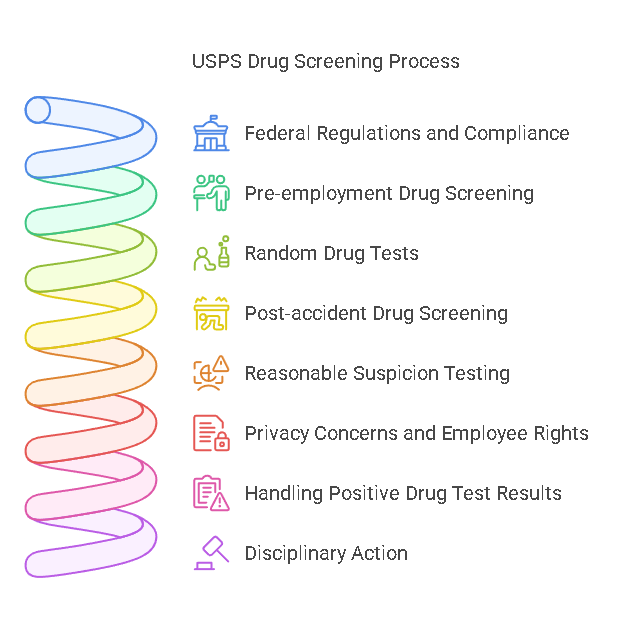Everything You Need to Know About USPS Drug Screening Process
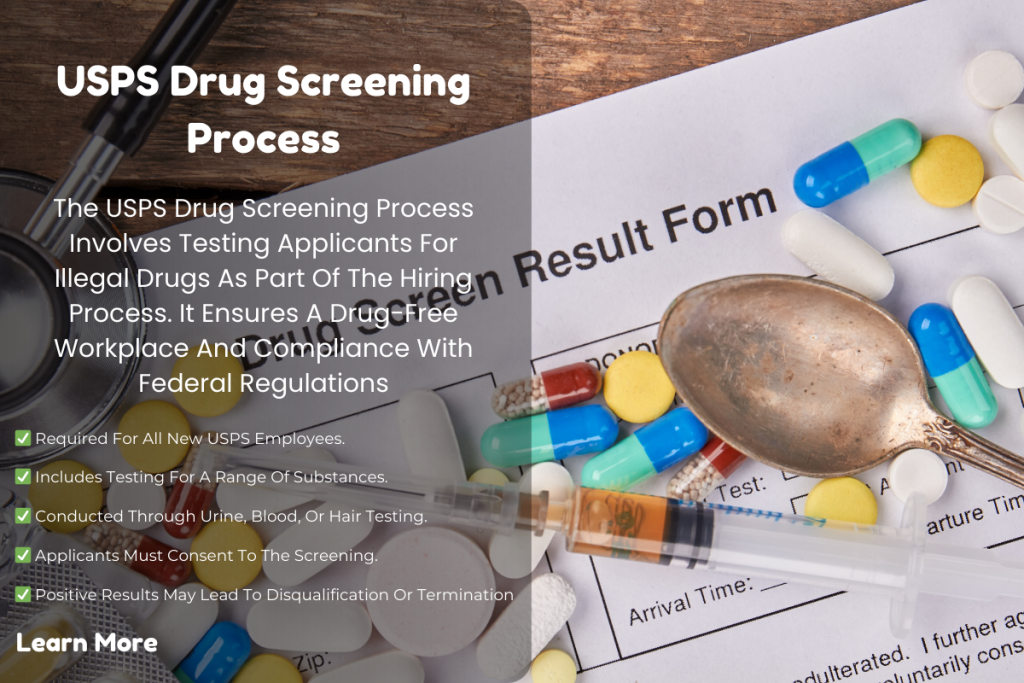
Introduction to USPS Drug Screening
The United States Postal Service (USPS) is one of the largest and most important federal agencies, responsible for providing mail and package delivery services across the United States. As a federal entity, the USPS has specific requirements and regulations that it must follow to ensure a safe, secure, and effective working environment for its employees. One of the most critical components of maintaining a safe and reliable workforce is the implementation of drug screening as part of the employment process. This drug testing ensures that employees adhere to federal and workplace policies that aim to maintain a drug-free environment.
This section will explore what USPS drug screening is, why it is important in the hiring and management process, and how it contributes to maintaining a drug-free workplace. We will also discuss the types of drug tests used by the USPS, such as urine tests, hair follicle tests, and saliva tests, as well as when these screenings are conducted.
What is USPS Drug Screening?
USPS drug screening refers to the process by which employees or potential employees are tested for the presence of illegal drugs or controlled substances. It is an essential part of the hiring process for individuals seeking employment within the USPS, as well as for those who are already employed by the postal service. Drug testing is not limited to new hires but extends to current employees through random testing, post-accident testing, and, in some cases, after a reasonable suspicion of drug use.
The primary goal of drug screening within the USPS is to create and maintain a safe work environment where employees are not impaired by drugs while on the job. Given the nature of postal service work, which involves operating heavy machinery, driving vehicles, handling mail, and interacting with the public, ensuring that workers are not under the influence of drugs is crucial for both safety and operational efficiency.
Why is USPS Drug Screening Important?
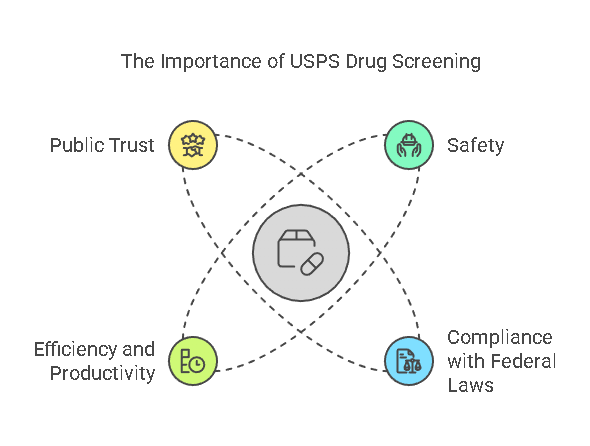
The implementation of drug screening within the USPS is important for several reasons:
- Safety: USPS employees may be required to operate vehicles, equipment, or machinery as part of their daily responsibilities. A worker under the influence of drugs could pose a significant safety risk to themselves and others, leading to accidents or injuries.
- Compliance with Federal Laws: As a government agency, the USPS is required to adhere to federal laws and regulations that mandate a drug-free workplace. These regulations include the Drug-Free Workplace Act of 1988 and other federal policies that ensure employees working for government agencies are free from the influence of illegal substances.
- Efficiency and Productivity: Employees who are under the influence of drugs are more likely to make mistakes, be less productive, and engage in unsafe behaviors. Drug testing ensures that employees can perform their duties effectively and efficiently, which is essential for maintaining the USPS’s reputation for delivering services in a timely and secure manner.
- Public Trust: The USPS handles sensitive materials, including legal documents and personal packages. It is crucial that customers have confidence in the professionalism and reliability of postal workers. A drug-free workforce helps maintain the public’s trust in the postal service’s ability to deliver on its promises.
Types of Drug Tests Used by USPS
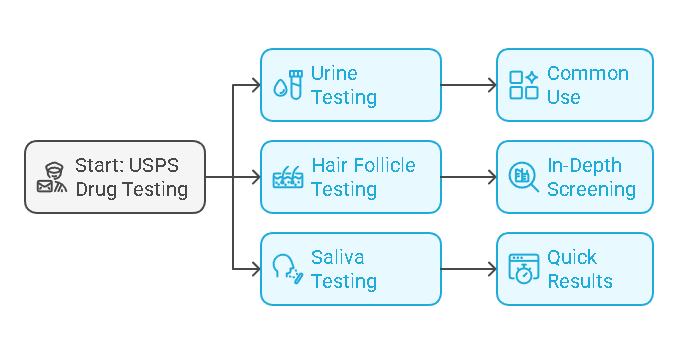
The USPS uses several types of drug tests to ensure that their employees adhere to federal and workplace policies regarding drug use. These tests are designed to detect a range of substances, including marijuana, cocaine, opioids, amphetamines, and other illegal drugs. Below is an overview of the common types of drug tests used by USPS:
1. Urine Drug Testing
Urine testing is the most common method used by the USPS for drug screening. This test involves the employee providing a urine sample, which is then sent to a certified laboratory for analysis. Urine tests are effective for detecting recent drug use, typically within a window of 1 to 3 days. They are highly effective at identifying substances such as marijuana, cocaine, opiates, amphetamines, and phencyclidine (PCP). Urine tests are often the default choice for pre-employment drug screening, random drug tests, and post-accident testing.
2. Hair Follicle Testing
Hair follicle testing is less common but may be used by the USPS for more in-depth screenings, especially in situations where there is concern about a pattern of drug use over a longer period. Hair follicle tests have a longer detection window—typically up to 90 days—making them ideal for detecting drug use over a more extended period. A small sample of hair is taken from the employee, and the laboratory tests it for traces of drugs. This test is typically more expensive than urine testing but can provide valuable insight into long-term drug use patterns.
3. Saliva Drug Testing
Saliva testing is sometimes used by USPS for certain situations, such as random drug testing or post-accident testing. The saliva test is quick and non-invasive, requiring only a simple mouth swab. This method is effective at detecting recent drug use, typically within the past 24 to 48 hours. Saliva testing is ideal for situations where immediate results are necessary, such as after an accident or if an employee is suspected of being under the influence at work.
When Does USPS Drug Screening Occur?
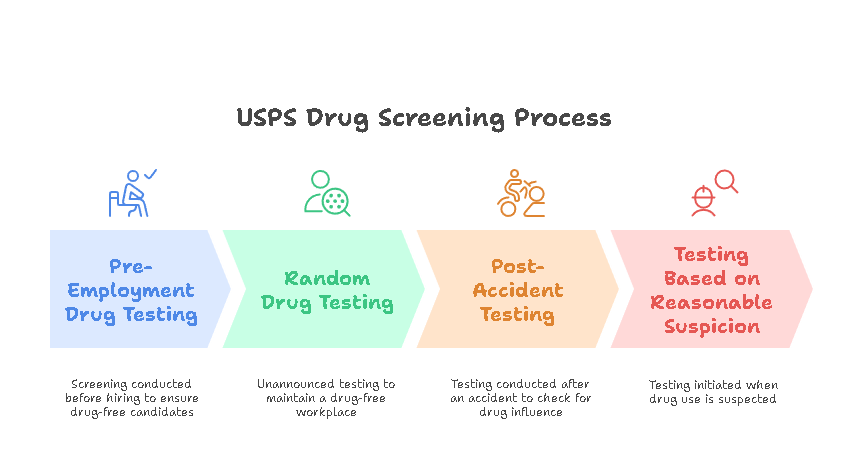
Drug screening at USPS can occur at various points during an employee’s career, and each situation has specific guidelines and regulations associated with it. Below are the common circumstances under which USPS drug screening may take place:
1. Pre-Employment Drug Testing
Before an individual can officially be hired by the USPS, they must undergo a pre-employment drug screening. This is a standard procedure for all potential new hires. The pre-employment drug test ensures that the candidate is free from illegal drugs and is in compliance with the USPS’s drug-free workplace policies. This step is crucial for maintaining a safe and productive work environment from the outset.
2. Random Drug Testing
After being hired, USPS employees may be subjected to random drug testing as part of the agency’s ongoing commitment to a drug-free workplace. Random testing is conducted without prior notice and is intended to discourage drug use among employees. The selection process is typically random, meaning that all employees have an equal chance of being chosen for testing.
3. Post-Accident Testing
If a USPS employee is involved in a workplace accident, they may be required to undergo a post-accident drug test. This is done to determine whether drugs played a role in the accident. Post-accident testing is important for ensuring that employees involved in accidents are not impaired by drugs, which could have contributed to the incident.
4. Testing Based on Reasonable Suspicion
If a supervisor or manager has reasonable suspicion that an employee is using drugs or is under the influence while on duty, the employee may be required to undergo drug testing. Reasonable suspicion can be based on observed behavior, such as erratic actions, slurred speech, or other signs of impairment. The USPS follows specific protocols to ensure that this testing is done fairly and appropriately.
How Precisehire Can Assist with USPS Drug Screening
At Precisehire, we understand the complexities of the USPS drug screening process and how critical it is for businesses and organizations to maintain a drug-free workplace. Our comprehensive drug screening services are designed to help individuals and companies navigate the various testing methods, ensuring compliance with federal regulations and USPS-specific requirements. We provide streamlined solutions that save time and ensure accuracy, from pre-employment screenings to random testing and post-accident drug tests.
We also assist in ensuring that companies stay compliant with all relevant federal laws, protecting both employees and employers. If your business needs reliable, efficient drug screening solutions, Precisehire is your trusted partner for ensuring a safe and drug-free workforce.
A Detailed Guide to the USPS Drug Screening Process: Procedures, Testing Methods, and What to Expect
When it comes to ensuring a safe and productive workforce, the United States Postal Service (USPS) takes drug testing seriously. The USPS drug screening process is a vital aspect of the hiring process, maintaining a drug-free workplace, and ensuring the safety of both employees and the public. In this section, we’ll explore the detailed steps involved in the USPS drug screening process, the different testing methods used, and what you can expect if you are selected for testing.
The USPS Drug Screening Process: Step-by-Step
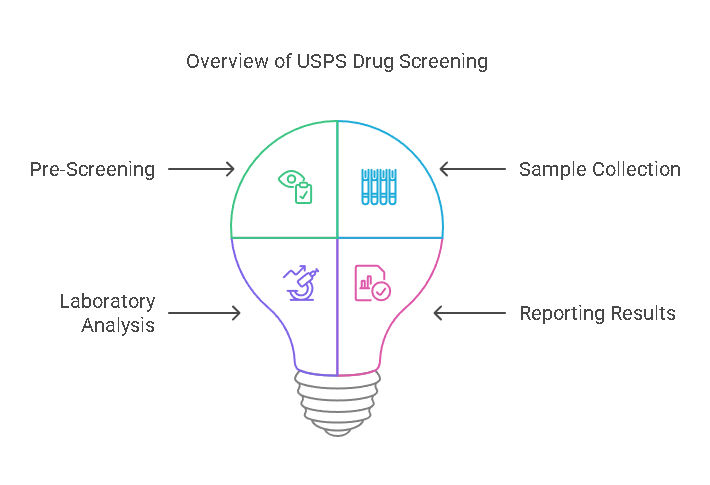
The USPS drug screening process follows a clear, structured procedure designed to ensure fairness and consistency. If you are a current or prospective USPS employee, it’s important to understand each phase of this process, including pre-screening, testing, collection, and the reporting of results.
1. Pre-Screening: Eligibility and Selection
Before any testing takes place, the USPS will determine whether an employee or applicant is eligible for drug screening. Drug tests may be required at different stages of employment, such as:
- Pre-Employment: New hires must undergo drug screening before they are officially hired. This is often a condition for employment.
- Random Testing: Once employed, USPS workers may be randomly selected for drug testing throughout their career to ensure compliance with USPS drug-free policies.
- Post-Accident: If an employee is involved in a workplace accident or incident, drug screening is often mandated to rule out substance abuse as a contributing factor.
- Reasonable Suspicion: If there is a reasonable suspicion that an employee is under the influence of drugs or alcohol while on the job, they may be required to undergo drug testing.
During the pre-screening phase, the USPS ensures that the individuals selected for drug testing meet the necessary criteria, such as holding the appropriate position or having been involved in a situation that requires testing.
2. Collection of Samples
Once selected for testing, the next step in the process is sample collection. The USPS typically uses certified medical professionals or third-party collection sites to handle this process, ensuring that all samples are collected under strict guidelines.
Common Sample Types:
- Urine Samples: This is the most common method used for drug testing at USPS. Urine samples are collected in a private setting to ensure accuracy and confidentiality.
- Hair Follicle Samples: In some cases, hair follicle testing is used, as it can detect long-term drug use, making it particularly effective for detecting substances that may not be visible in urine tests.
- Saliva Samples: Saliva tests are less common but may be used for certain types of drug screening. They are non-invasive and can be administered quickly, although they have a shorter detection window compared to urine or hair tests.
During the collection process, strict chain-of-custody procedures are followed to ensure that the sample remains untampered with and that the results can be trusted.
3. Testing: Laboratory Analysis
Once the samples are collected, they are sent to an accredited laboratory for analysis. The laboratory tests the samples for the presence of illicit substances, and the results are typically available within a few days. In some cases, a lab will perform an initial screening followed by a confirmatory test to ensure the accuracy of the results.
What Drugs Are Tested For?
The USPS typically tests for the following substances, though the exact list may vary depending on the type of test and its purpose:
- Marijuana (THC): A substance often tested for in the context of recreational use.
- Cocaine: A powerful stimulant that is commonly tested for, especially in employment drug screenings.
- Opiates: Including heroin, morphine, and codeine, these substances are tested due to their high potential for abuse and dependence.
- Amphetamines: Including methamphetamine and ecstasy, both of which are commonly abused.
- Phencyclidine (PCP): A powerful hallucinogen that is a common target in drug testing.
- Alcohol: While not always tested in routine drug screening, alcohol use may be tested post-accident or under reasonable suspicion.
It’s important to note that USPS drug screenings are designed to be highly accurate, with false positives or false negatives being rare, but possible. Therefore, confirmatory tests are typically conducted to ensure the reliability of results.
4. Reporting Results
After the samples are tested, the laboratory will report the results to the USPS. If the test is negative, the employee or applicant can move forward in the process without any issues. However, if the results are positive, further action will be taken, depending on the type of test and the circumstances surrounding it.
- Negative Results: If no illicit substances are found, the applicant or employee is cleared to move forward in the process, or they can continue working without issue.
- Positive Results: If a drug test yields a positive result, the employee may face consequences. For pre-employment testing, a positive result may disqualify the individual from the job. For current employees, disciplinary action may range from suspension to termination, depending on the severity of the violation and the employee’s history.
It’s worth noting that USPS employees have the right to challenge or dispute a positive result if they believe there has been a mistake or if they have a legitimate medical reason for the presence of a substance in their system (e.g., a prescription for a controlled substance). In such cases, the employee may be required to provide documentation supporting their claim.
USPS Drug Testing: The Importance of Compliance
The USPS’s commitment to maintaining a drug-free workplace helps ensure that employees are productive, safe, and responsible in their roles. As a federal agency, the USPS is also required to comply with various federal regulations related to drug-free workplaces, including the Drug-Free Workplace Act of 1988, which mandates that federal employees undergo drug testing under specific circumstances.
The drug screening process also protects employees from unsafe work conditions and upholds the integrity of the workplace. Testing helps identify individuals who may pose a risk to themselves, others, or the organization due to substance abuse.
How Precisehire Can Help
Navigating the complexities of USPS drug screening can be challenging for businesses, HR departments, and individuals. At Precisehire, we specialize in providing comprehensive drug screening solutions tailored to meet the needs of businesses and individuals. We offer seamless integration of testing services, ensuring that you remain compliant with USPS requirements and other industry standards.
By partnering with Precisehire, businesses can benefit from faster turnaround times, professional guidance, and a streamlined approach to drug screening. Whether you’re looking for pre-employment testing, random testing, or post-accident testing, Precisehire ensures that your organization stays ahead of potential risks while adhering to the highest standards of safety and compliance.
Comparison of Drug Testing Methods
Below is a table comparing the different types of drug testing methods used by USPS, highlighting their effectiveness and detection windows:
| Testing Method | Detection Window | Substances Detected | Pros | Cons |
|---|---|---|---|---|
| Urine Test | 1-5 days | Marijuana, cocaine, opiates, amphetamines, PCP | Common, cost-effective, well-established | Short detection window for some substances |
| Hair Follicle | Up to 90 days | Marijuana, cocaine, opiates, amphetamines, PCP | Detects long-term drug use | More expensive, invasive |
| Saliva Test | 1-2 days | Marijuana, cocaine, amphetamines | Non-invasive, quick results | Short detection window |
| Blood Test | Hours to 1-2 days | Alcohol, illicit drugs | Very accurate, detects recent use | Invasive, expensive |
Each method of drug testing has its own strengths and weaknesses. The type of test chosen will depend on the specific needs of the USPS, as well as the situation in question (e.g., pre-employment, post-accident).

